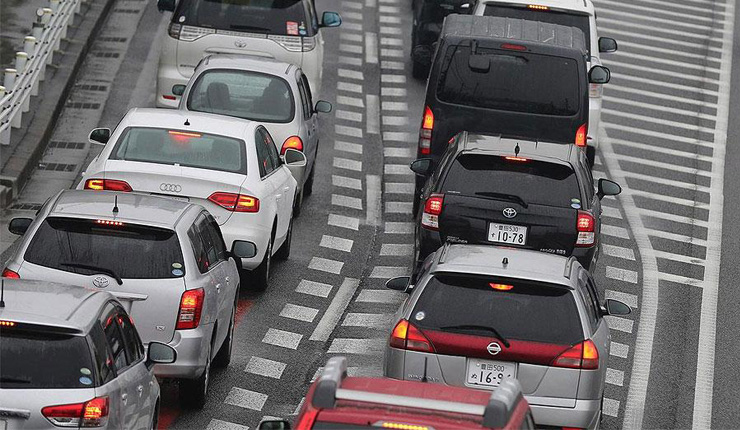
TOKYO — As Japan races to preserve U.S. trade ties after President Donald Trump withdrew from a Pacific trade pact, Prime Minister Shinzo Abe faces a dilemma that has plagued Japanese leaders since the 1980s: How to convince his citizens to buy American cars?
Trump singled out Japan for failing to purchase U.S. vehicles when he formally pulled out of the Trans-Pacific Partnership agreement on Monday. Japan is the second-largest economy among the 12 member nations and has been one of its leading advocates.
Abe has given no indication he’d entertain a TPP without the U.S., even as that goal is pushed by Australia. He told Japan’s parliament he still hoped to convince Trump of the merits of the agreement — a prospect that no other Asian TPP leader shared in statements on Tuesday.
Abe must now consider whether, or how, to placate the new U.S. administration, something Japan has done at other times since World World II to maintain healthy ties with its main security ally. Hemmed in by a pacifist constitution and a non-nuclear pledge, Japan relies on the U.S. to provide a “nuclear umbrella” to protect it from regional threats, including its neighbor China.
Political costs
Any retreat from the TPP has the potential to damage Abe at the polls — in championing TPP he risked the wrath of the farm lobby that has been a key political base for his party.
Deputy Cabinet Secretary Koichi Hagiuda denied a Nikkei newspaper report that Japan would set up a new office to take charge of trade negotiations, such as with the EU.
Some members of the prime minister’s office want Japan to do a bilateral deal with the U.S., said a person who’s involved in trade policy, asking not to be named as the discussions are still ongoing. However, any decision on who in government would take the lead will happen after Abe meets Trump so the administration doesn’t signal it’s intentions, the person said.
Still, he can delay a decision on whether to now seek a bilateral trade deal until after an election that could come late this year or early in 2018, according to Hiroyuki Kishi, a former trade ministry official who is now a professor at Keio University in Yokohama. Abe’s approval rating remains high and the main opposition party is weak.
“Relations with the U.S. are the top priority, so the prime minister’s office will have to make some concession,” Kishi said. “At the same time, they will seek to build a relationship of trust between Abe and Trump and persuade Trump to return to multilateral agreements.”
Key to any deal will be vehicles. Trump said on Monday that Japan does “things to us that make it impossible to sell cars in Japan, and yet, they sell cars into us and they come in like by the hundreds of thousands on the biggest ships I’ve ever seen.” He described the situation as “unfair.”
Japanese Trade Minister Hiroshige Seko rejected that characterization on Tuesday.
No discrimination
“The fact is that Japan does not apply tariffs to U.S. cars at all and regarding non-tariff areas, we do not discriminate against them at all in comparison with Japanese cars,” he said. “I want to explain this to the U.S. side when I have an opportunity.”
Japan has the fourth-largest trade surplus with the U.S. after China, Mexico and Germany. It exported more than 1.6 million vehicles to America in 2015, while the U.S. sold less than 19,000 vehicles to Japan.
Despite that, about 418,000 cars and trucks were exported from Japanese auto plants in the U.S. to other countries in 2015, according to the Japan Automobile Manufacturers’ Association. Some 75 percent of Japan-branded cars sold in the U.S. are built in North America, it said, without providing a breakdown of how many were made in Mexico — another Trump trade target.
Ford Motor Co. had opposed the TPP, in part because of what it said was currency manipulation from Japan. In 2013, then-CEO Alan Mulally called Japan “the most closed market in the world.”
Toyota invests
Representatives for Honda Motor Co., Nissan Motor Co. and Subaru declined to comment Tuesday on the U.S. pulling out of the TPP or Trump’s comments. Toyota Motor Corp., which was criticized by Trump over its plans to build a plant in Mexico, announced that it would invest $600 million and add 400 jobs at an assembly plant in Indiana.
The Obama administration had touted measures in the TPP to address non-tariff barriers that hinder American vehicle exports to Japan. They included transparency in Japan’s regulatory process, eased restrictions on standards and new technologies, consistent zoning rules that make easier to sell throughout the country and a safeguard in case the TPP led to a surge in imports after tariffs were eliminated.
Now Japan must consider whether to move forward on a bilateral deal with the U.S., something the Trump administration prefers.
Jun Okumura, a former Japanese trade negotiator who is a visiting scholar at the Meiji Institute for Global Affairs, said it’d be fairly straightforward to transfer the provisions of the TPP into a bilateral agreement. Yet Trump would need to be able to say he got a better deal, and it’s unclear what that would mean for Japan.
‘Sticky mind’
Automobiles are “something that’s going to continually come up,” Okumura said. “Trump has a very sticky mind. I thought his handlers had made him leave that behind, but apparently not.”
Instead of a trade deal, Trump may find his branding experience more useful. Many Japanese eschew U.S.-made cars for a simple reason: a perception of poor quality.
“I wouldn’t mind driving American cars if they didn’t need maintenance for a year,” said Kunihiko Miyake, a former diplomat who is now visiting professor at Ritsumeikan University. “Cost-performance wise, American cars are not good. That’s why I don’t buy them, not because of the non-tariff barriers.”
Photo credit: Bloomberg


